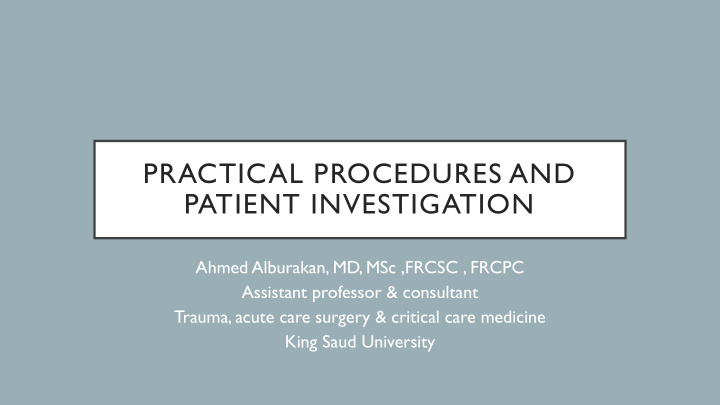



PRACTICAL PROCEDURES AND PATIENT INVESTIGATION Ahmed Alburakan, MD, MSc ,FRCSC , FRCPC Assistant professor & consultant Trauma, acute care surgery & critical care medicine King Saud University
OUTLINE • Introduction • Abdominal procedures • General precautions • Vascular procedures • Aseptic technique • Urinary procedures • Local anaesthesia • Central nervous system procedures • Suturing • Excision of lumps and swellings • Airway procedures • Imaging • Thoracic procedures
GENERAL CONSIDERATIONS • Every procedure should be preceded by adequate explanation. • Reason for procedure, simplified steps, what is expected during the procedure. • Communication and reassurance throughout the procedure. • Counselling regarding the need, the benefit and any alternatives to the procedure. • Written informed consent is required sometimes.
GENERAL PRECAUTIONS • Needles should not be resheathed. • Sharp instruments discarded by the operator should be placed in a special ‘sharps’ container. • Drapes and other soiled equipment should be placed in appropriate containers. • Gloves and gown should only be removed after all used equipment / drapes have been placed in appropriate containers.
ASEPTIC TECHNIQUE ’using practices and procedures to prevent contamination from pathogens. It • involves applying the strictest rules to minimize the risk of infection’ • As a minimum precaution, the skin should be cleansed with an antiseptic solution, and sterile instruments used. • For some procedures, full aseptic technique should be employed.
ASEPTIC TECHNIQUE
ASEPTIC TECHNIQUE
LOCAL ANAESTHESIA • Local anaesthetic agents inhibit membrane depolarization and hence block the transmission of nerve impulses. • Either topical, or local infiltration. • Local anaesthetic drugs are potentially toxic and care must be taken to avoid inadvertent intravascular injection. • Signs of toxicity: numbness, tingling, tinnitus, light headedness • Higher doses: LOC, convulsions, arrythmias
LOCAL ANAESTHESIA
SUTURING
SUTURING
SUTURING
AIRWAY PROCEDURES
AIRWAY PROCEDURES
AIRWAY PROCEDURES
AIRWAY PROCEDURES
THORACIC PROCEDURES
ABDOMINAL PROCEDURES
SUMMARY • Protect yourself, colleagues and the patient. • Aseptic technique. • Talk to your patients, and the rest of the team. • Know indications, alternatives, complications of the procedure you are performing.
Recommend
More recommend